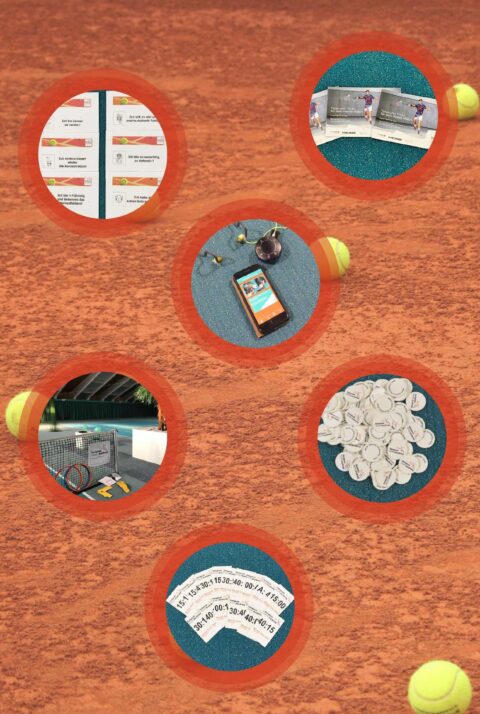Generally speaking, there are two ways to improve in tennis. One is mechanical learning: hitting as many balls as possible to automate the movements. We’ve found that among the 2,000-3,000 club players who book our courses each year, there are very few who have the time and desire to train this way for 3 to 4 hours a week. The second way of learning is through self-awareness, that is, by consciously feeling what I’m doing. Feeling what my racket, my body, and the ball are really doing is often a surprise.
Tennis training made exciting and effective!
ETA blog article February 2020 by Kurt Wiederkehr (sports psychologist, founder & partner of the European Tennis Academy)
What I want, what I believe, and what I do are different realities. Recognizing this difference means learning, because I learn very little by just killing balls. To make the process of self-awareness exciting and entertaining, we have developed various tools.

“Mental Match Play Aids” by European Tennis Academy
Tennis with music
We worked with a music teacher for over two years to compose music that promotes perception and concentration while playing tennis. The result is 23 exercises accompanied by music. Our course participants are continually amazed at the immediate improvement in their game and how pleasant it is to play in a flow.
In class, we use a radio system so that up to eight people can practice with this music at the same time. We use this music sporadically and situationally throughout the class program.
You can also continue training with music at home! Simply download the MMP training program from the “Tennis with Music” app to your smartphone and connect it with Bluetooth headphones. Let the rhythmic and intensive training begin. By the way, the first lesson with the basic exercises is free. The four additional lessons cost just CHF 3 each!
Focus cards
“Where our attention is, that’s where learning takes place,” says Tim Gallwey in his best-selling book “The Inner Game of Tennis.” Instead of constantly correcting ourselves, we observe various points in our stroke, our body, or the ball.
To stay fully engaged and support the impact of this observation, we’ve developed focus cards with the corresponding exercises. We place these at the back of the curtain or screen so we can constantly remind ourselves of it!
As we know, tennis players get distracted very quickly!
Charly Chips
To improve and train concentration in a fun way, we use our Charly Chips. We call the voice in our head “Charly”! If we manage not to argue with Charly (self-reproach and such), concentration and focus suddenly appear.
With these chips, we can more easily tell whether we’re preoccupied with Charly (thinking) or whether we’re actually performing the observation exercise. Between rallies, I swap a Charly chip from one pocket to the other if Charly catches me again!
Reset Ritual
Compared to other sports, we have a huge advantage in tennis: we can always regain focus between rallies. Skiers or skydivers can’t stop and start again! From one point to the next, we have 20 seconds to prepare. This is a crucial time in a match. Either I’m fully focused or I’m still fuming about that last stupid mistake!
To achieve the much-praised “point-by-point mentality,” structuring this break time helps.
Phase 1 – Releasing Emotions (6.666 seconds)
When we swallow/suppress our emotions, they are still there, hidden away, and continue to bother us.
We need to release them in order to be free. “It’s over, I can’t change it!”
Phase 2 – Visualize your focus in your mind (6.666 seconds)
In slow motion, I see myself performing the chosen focus (visualize).
Phase 3 – Create High Readiness (6.666 seconds)
I go to the baseline and activate my legs and mental readiness for the serve or return. Let’s go!
This ritual keeps me busy and leaves me with no time to blame myself or make resolutions, because resolutions are activated doubts! With our three focus cards, we practice this ritual much more consciously!
Personal confidence analysis in our shots
It’s no secret, when I’m looking forward to something I’m in a different state than when I’m afraid of something!
Although I do make mistakes on my strong forehand, for example, they have a different impact on my confidence than if I miss my crutch backhand!
Assuming I can look forward to my backhand, it changes my stroke! With our confidence map, we observe this change with a “before and after” assessment!
Feedback rounds
Others feel the same way! By briefly discussing the effects of the exercise together, I can better and more comprehensively recognize the changes that have taken place. Time and again, we find that the guests rate themselves worse than they actually performed.
“All balls were out!” “I didn’t hit ANY ball properly!”
The trainer’s questions are crucial. They should be solution-oriented, not problem-solving or even accusatory:
What did this exercise change about my backhand?
What made things better?
When do we apply this focus in the next match/training?


